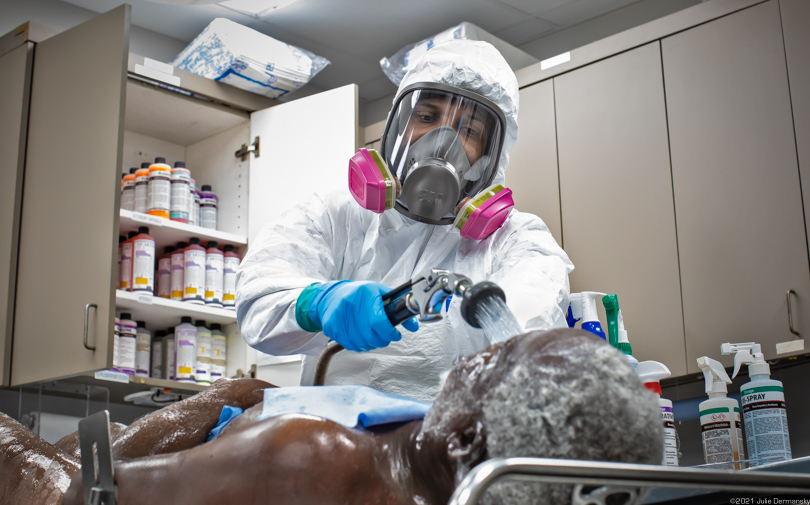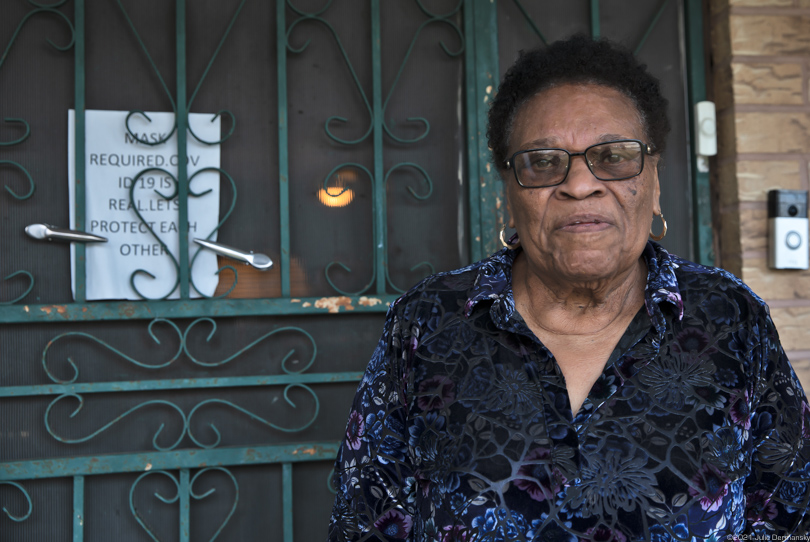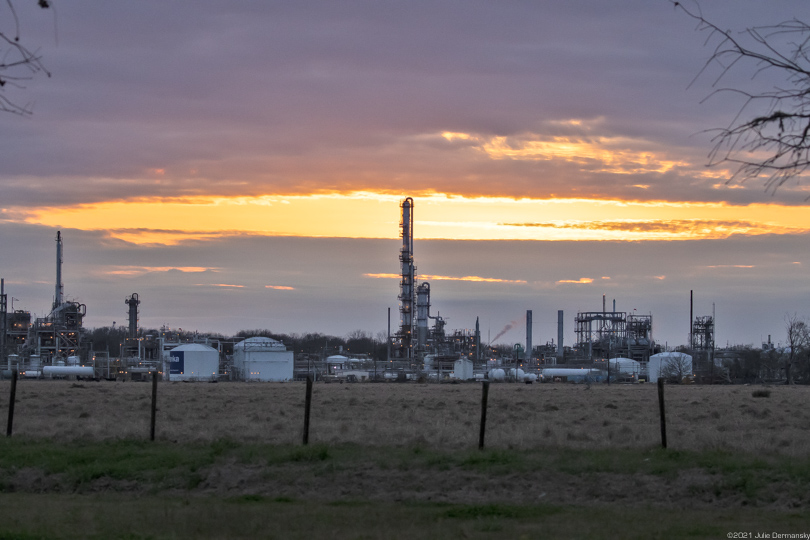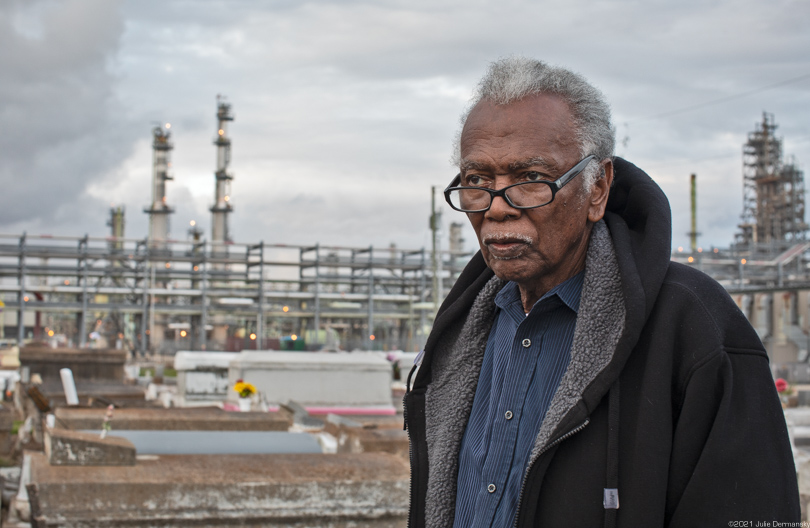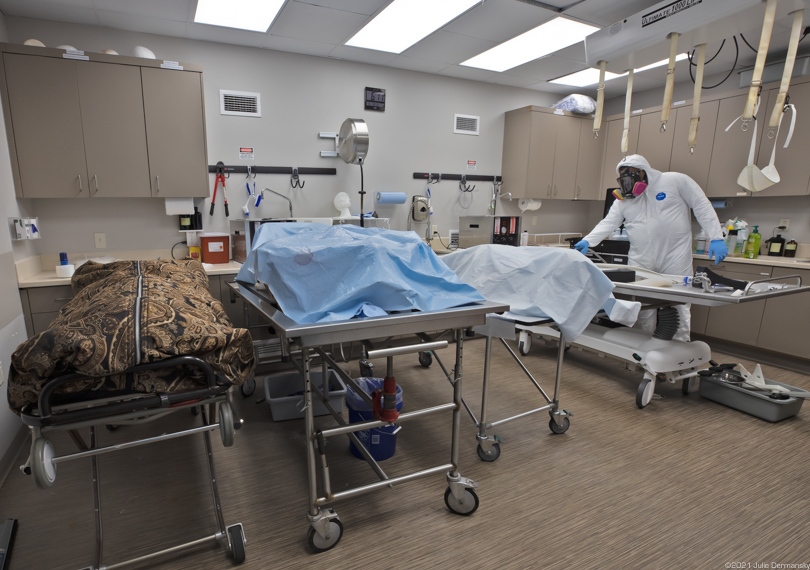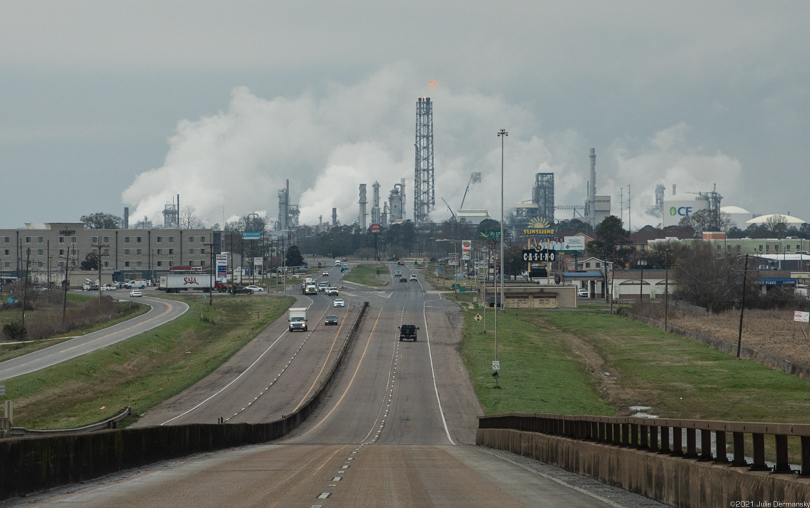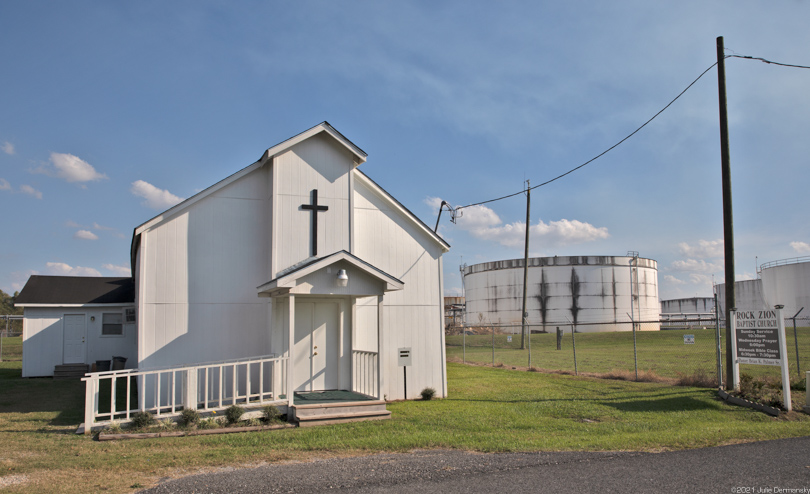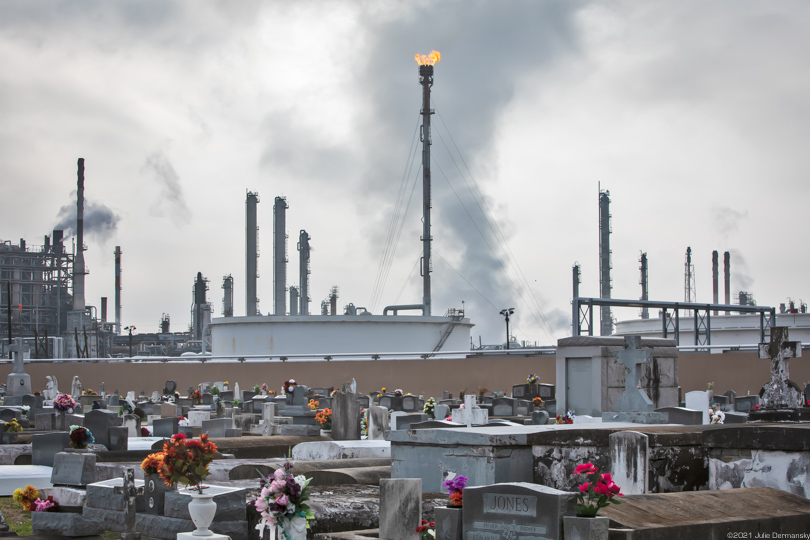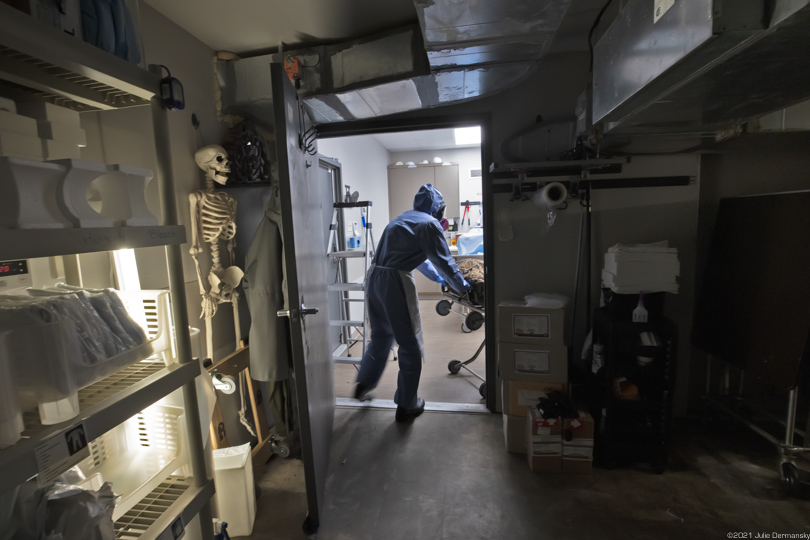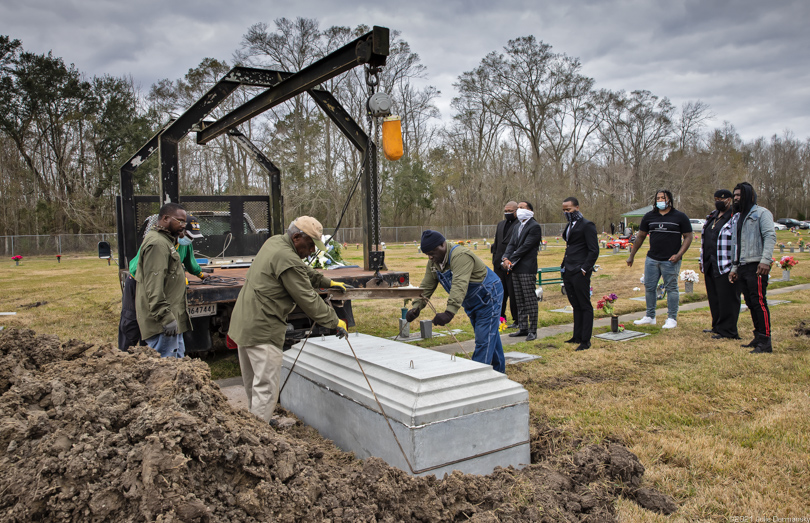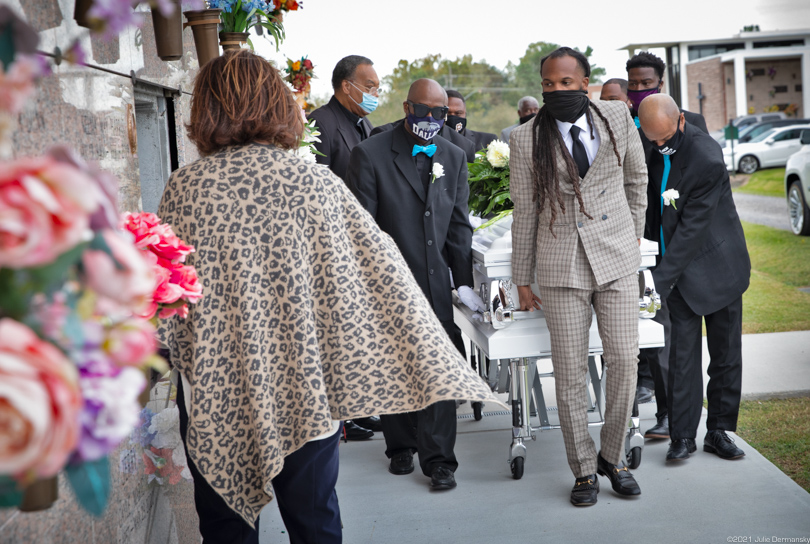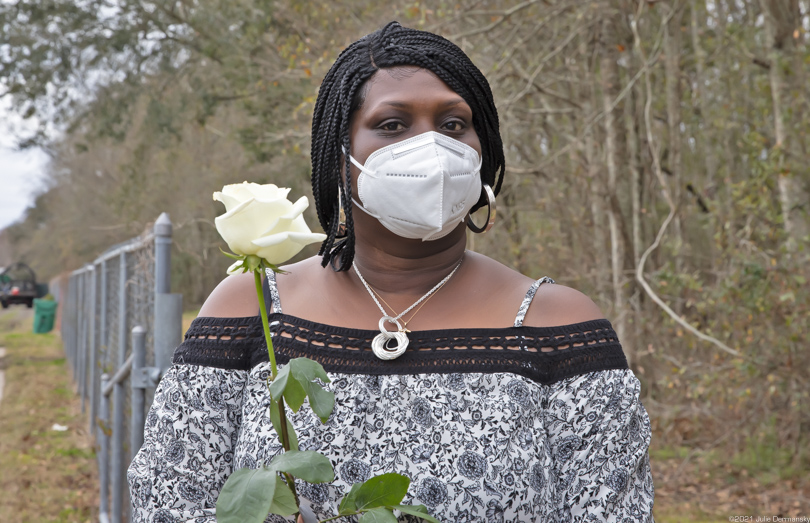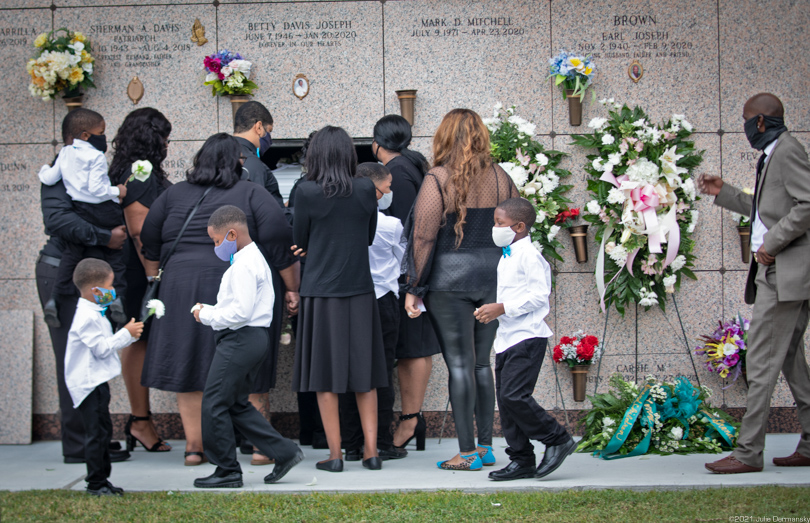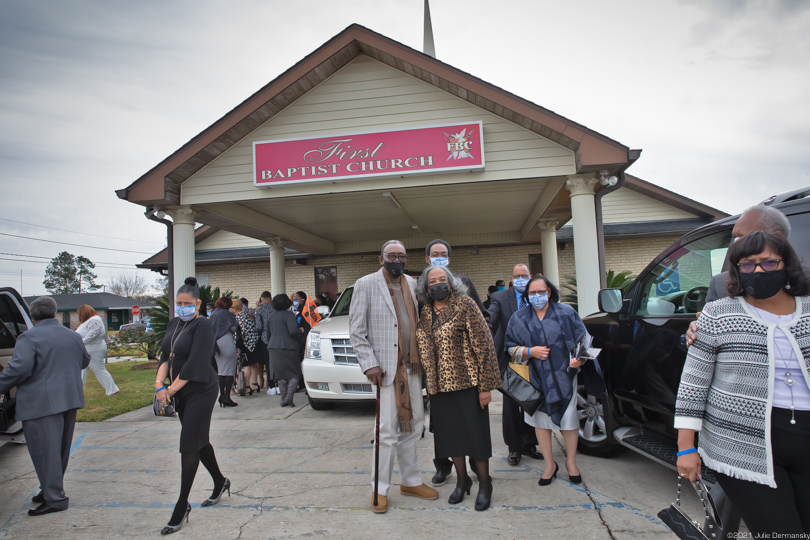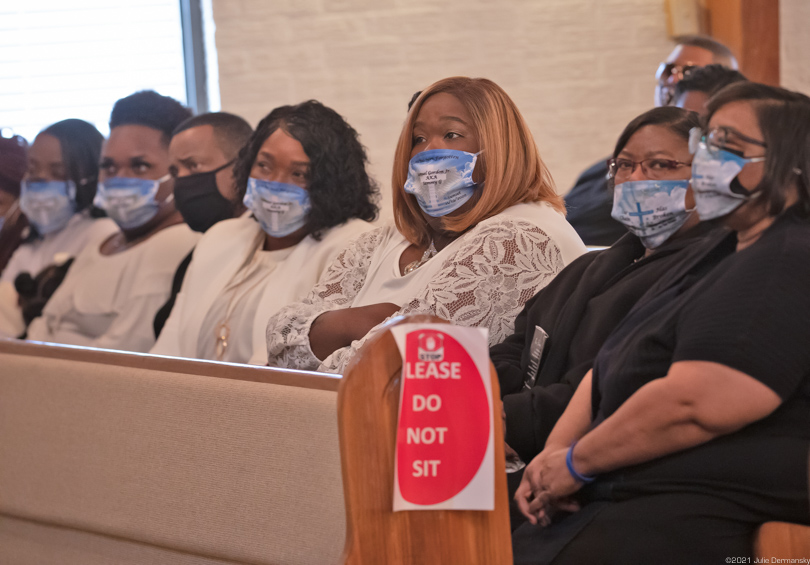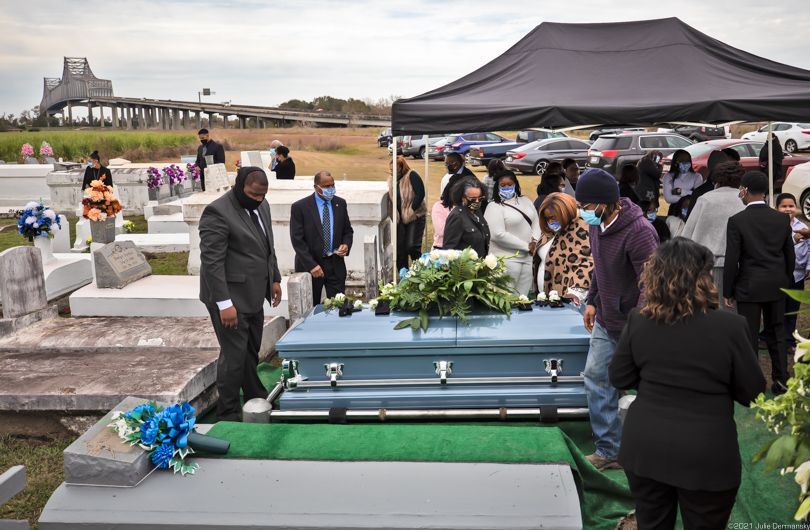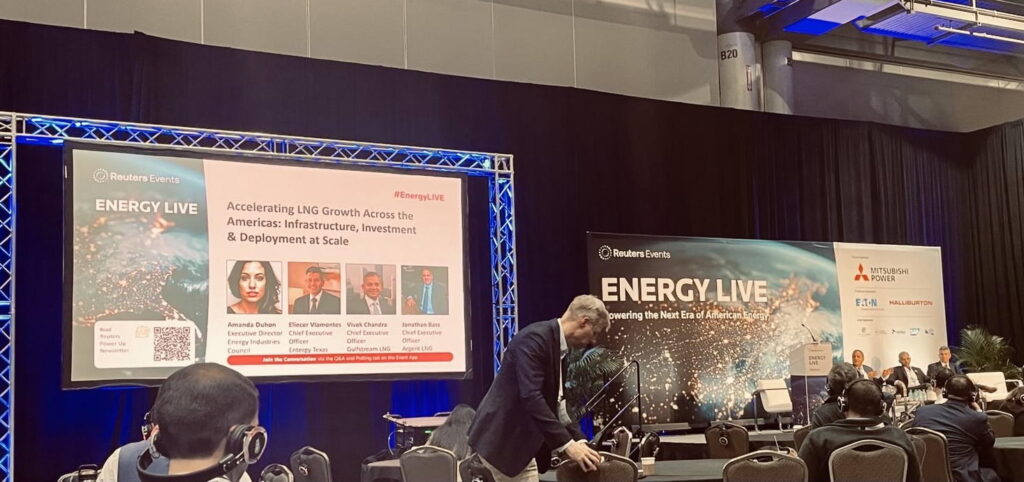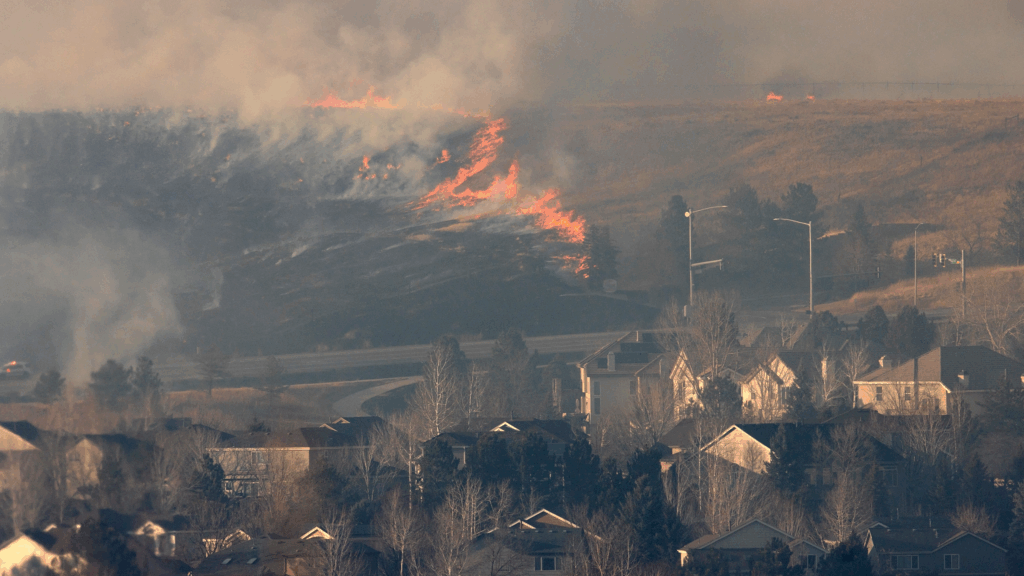Mary Hampton, president of the Concerned Citizens of St. John the Baptist Parish, a community group in Louisiana fighting for clean air, opted to do everything in her power to avoid getting the coronavirus after Robert Taylor, the group’s founder, was hospitalized with COVID-19 earlier this year. So she got vaccinated as soon as she could. “Either the vaccine is going to make me sick,” Hampton reasoned, “or the virus is going to kill me.”
Like many African Americans, Hampton’s hesitation around vaccination stems from hearing about the way Black men were left to suffer during the Tuskegee syphilis study, an experiment between 1932 and 1972 which withheld lifesaving treatment, and from her own lifetime of experiences with unequal healthcare access. She told me that she and her family often had to wait hours to see a doctor for medical care while white people would go right in.
Mary Hampton at her home near the Denka plant, in St. John the Baptist Parish on February 9, 2021. Credit: Julie Dermansky.
The Denka Performance Elastomer Plant in St. John the Baptist Parish. Credit: Julie Dermansky
Hampton and Taylor live less than a mile from the Denka Performance Elastomer chemical factory in Louisiana’s St. John the Baptist Parish. This community lies in the middle of Cancer Alley, an 80-mile stretch along the Mississippi River between New Orleans and Baton Rouge that is lined with more than a hundred refineries and petrochemical plants.
Their fenceline community had been exposed to harmful air pollution for 46 years before DuPont sold this petrochemical factory, which produces synthetic rubber, to Denka on November 1, 2015.
Robert Taylor visiting the Zion Travelers Cemetery, next to the Marathon Refinery, in Reserve, Louisiana where some of his relatives are buried on December 3, 2020. Credit: Julie Dermansky.
Then, in late 2016, Taylor started the citizens group when the small, majority Black community learned that for decades this factory had been exposing them to many toxic chemicals, including chloroprene, which the Environmental Protection Agency (EPA) found is a likely human carcinogen.
According to the EPA’s National Air Toxics Assessment published in 2015 — which evaluates air contaminants and estimates health risks — residents near Denka’s plant were determined to have the highest lifetime risk of cancer from air pollution in the country, nearly 50 times the national average.
Covid Hotspot
In mid-March last year as the pandemic spread in the United States, Louisiana was identified as a hotspot for the virus, with the steepest curve of COVID-19 infections in the country.
At an April 5, 2020 press conference, Louisiana Gov. John Bel Edwards identified the African-American community in St. John the Baptist Parish as having an alarming death rate. A few days later, the governor announced the new Louisiana COVID-19 Health Equity Task Force, created to look at how health inequities are affecting communities most impacted by the coronavirus.
Bodies coronavirus victims at the Treasures of Life Funeral home during the second surge of the pandemic. Credit: Julie Dermansky.
Almost a year later, Hampton told me that she doesn’t find anything equitable about how her community has been treated during the pandemic. The Concerned Citizens group believes that equity for their community should start with the government making the Denka plant cut its emissions to meet the maximum level of chloroprene deemed safe by the EPA for humans to inhale over a lifetime.
The Concerned Citizens group isn’t satisfied with Denka’s emission reductions, which were cut by as much as 85 percent after the Louisiana Department of Environmental Quality (DEQ) and the EPA ordered Denka to do so. Emissions, however, are still consistently above the EPA’s recommended level, and the group wants the government to do more.
If the state is serious about creating health equity, Hampton thinks her community should have received access to the vaccines first, given their compromised immune systems and chronic exposure to harmful air pollution. “But that isn’t happening,” Hampton explained.
“I was able to get a vaccine since I’m over 80 years old, but I couldn’t get them for my children who are all in their 50s, and they need them too.”
CF Industries in St. James Parish at the foot of the Sunshine Bridge. Credit: Julie Dermansky.
Covid and Chronic Pollution
Dr. Chip Riggins with the Louisiana Department of Health told me by phone that the state is doing everything it can to get vaccines to the Mississippi River Parishes including St. John the Baptist and nearby St. James Parish, but admits it isn’t happening as fast as they would like. Riggins explained numerous obstacles, from lack of pharmacies and health centers particularly on the West bank of the river to bad weather and a limited quantity of supply with the vaccine rollout.
Kevin Litten, a communications strategist with the Louisiana Department of Health, said via email, “Statewide, we have seen COVID-19 disproportionately affect communities of color.”
He pointed me to Louisiana’s COVID-19 dashboard and data provided on the department’s website when I asked if the health department could quantify the disparity in cases and deaths in St. John the Baptist and St. James Parish, compared to the rest of the state.
Rock Zion Baptist Church near Baton Rouge next to an industrial site. Credit: Julie Dermansky.
Dow’s St. Charles Chemical plant in Hahnville that recently made a settlement with the government to lower harmful emissions. Credit: Julie Dermansky.
A new study published in the European Journal of Environment and Public Health did just that. It used that exact data to evaluate the relationship between chronic exposure to air pollution and COVID-19 in Cancer Alley. The study found higher rates of COVID-19 infection and death in Cancer Alley’s 11 parishes. Residents of St. John the Baptist were more than five times as likely to die of the disease than people in other parishes, the researchers found.
The findings support other research connecting the impacts of chronic air pollution on the pandemic in China, Europe, and other parts of the United States.
“These effects in the United States are due to inaction on environmental and structural injustices and health inequities in Louisiana,” the authors wrote. (Longtime Cancer Alley advocate and Louisiana GreenARMY founder, retired Lt. General Russel Honoré contributed to the study.)
The Burden on Black Communities
Courtney Baloney at work at his funeral home in St. James Parish, LA. Credit: Julie Dermansky.
One place where these racial injustices and inequities become magnified is in funeral homes. Courtney Baloney, the owner of the Treasures of Life Center for Life Funeral Services in St. James Parish has been busy since the start of the pandemic. I photographed Baloney at work early in the pandemic and returned to his funeral home when the second surge of infections and deaths started late last year and into this year.
Baloney finds it heartbreaking to watch the pandemic’s impact on the community, and he goes the extra mile to give those who have lost loved ones to the coronavirus all the support he can.
The Louisiana Department of Health acknowledged that it isn’t looking at potential connections between air pollution and COVID-19 hospitalization and death rates in Cancer Alley communities like St. John the Baptist Parish. “With COVID-19 being so new to Louisiana, the U.S., and the world, connecting the effects of the disease to environmental implications is still highly challenging. In Louisiana, we don’t currently have enough information to make these connections,” Litten said by email.
Baloney isn’t surprised that the Louisiana health department isn’t looking for a connection between air pollution and the pandemic’s death count, but he says that he sees the impacts in his own Cancer Alley community and in his work every day.
The Tulane Environmental Law Clinic published an analysis of the connection between COVID-19 and fenceline communities in May 2020. That early study found Black communities are overburdened with both COVID-19 deaths and air pollutants that harm the respiratory and immune systems.
“The COVID-19 pandemic reveals the urgent and critical need to reduce the burden of air pollution on Louisiana’s black and economically disadvantaged communities,” Kimberly Terrell, one of the authors of the report, later published in the journal Environmental Justice, said in a news release. “Our study, along with many others, provides evidence that long-term exposure to harmful air pollutants should be considered a pre-existing condition for COVID-19.”
Wilma Subra is a technical advisor to the environmental advocacy group Louisiana Environmental Action Network and has been working with the Concerned Citizens group since 2016. “If you wanted to study the connection between pollution and the impact COVID-19 is having on fenceline communities, more monitoring for volatile organic compounds and particulate matter should be done,” she told me. According to Subra, ideally the state should be monitoring both of these type of pollutants at the fencelines of all polluting plants next to residential areas. “Then you would look at results compared to the hospital records of the people that get the sickness,” Subra said
Taylor, now out of the hospital and regaining his strength, told me over the phone that he is not surprised that the State of Louisiana is not examining the potential connections between the bad air in his community and impacts from the coronavirus.
He and members of his group believe that state environmental regulators and the health department have been working against the group from the start. Taylor pointed out that Dr. Chuck Carr Brown, Secretary of the Louisiana Department of Environmental Quality, labeled the group as fearmongers at December 2016 Parish Council meeting when they asked the parish council to force Denka to cut chloroprene emissions to the level deemed safe by the EPA. Brown later tried to backtrack his comment but never expressed support for Denka to lower emissions more than 85 percent.
A health study done by the University Network for Human Rights (UNHR) that was released in July 2019 provided evidence that Taylor’s community is at pronounced risk of cancer and other negative health effects due to toxic chemicals in the air. A peer-reviewed and updated version of that report, which Taylor and Hampton contributed to, was published this year on February 18 by the journal Environmental Justice.
In November 2019, the Louisiana Department of Health announced plans to conduct a first-ever scientific inquiry into cancer cases around the Denka plant near St. John the Baptist Parish.
“Instead of doing anything to help us after the health study was published, the state decided to do its own study,” Taylor said. While he welcomes the state’s effort, he doesn’t think it should stop state regulators from acting to protect the community from the plant’s emissions in the meantime. “The EPA indicated an elevated risk of cancer for our community. We shouldn’t have to wait till we get cancer and can prove the EPA right.”
The Board of Health tasked the Louisiana State University to send students to homes within a 1.5 mile radius of the Denka plant to collect data on incidences of cancer and then match the data from residents with medical reports. If the data differs from what they find in the Louisiana Tumor Registry, which tracks the state’s cancer incidences, then that data will be updated.
Due to the pandemic, the survey is being done by phone instead of in person. However, Taylor doesn’t see how that approach can succeed in this community. He has yet to receive a call from anyone tied to the study, and the few community members he knows who have received a call told him that the questions they were asked didn’t make much sense to them. Hampton pointed out that community members she knows who did participate didn’t feel comfortable talking about their family’s health status over the phone.
Counting Deaths
A victim of Covid-19 being buried in St. Charles Parish, LA, on January 30, 2021. Credit: Julie Dermansky.
While the Louisiana Tumor Registry’s records don’t show an increase in deaths caused by cancer incidences linked to industrial pollution in Cancer Alley, some environmental advocates say they don’t have much confidence in the accuracy of those records. Neither does Baloney, the funeral home owner, who says he has no doubt that the oil refineries and petrochemical plants around him impact his community’s health.
The tumor registry bases its cancer count on reports from medical records, Baloney pointed out, but he has tended to many families who lost loved ones who hadn’t sought medical help before they died. With the increased deaths during the pandemic, the tumor registry will likely see a decline in deaths attributed to cancer, he says, because the coronavirus was the main cause of death for so many people, even if they also suffered from cancer.
Courtney Baloney leading pallbearers at a funeral in St. John the Baptist parish on October 10, 2020. Credit: Julie Dermansky.
Woman wearing an K95 mask at a funeral on January 30, 2021 for a loved one who died from Covid-19. Credit: Julie Dermansky.
Funeral in St. John the Baptist Parish in October 10, 2020 while the second surge of the pandemic hit Louisiana. Credit: Julie Dermansky.
On top of that, Baloney suspects that the state of Louisiana has undercounted the number of deaths due to the coronavirus from the start, due to the lack of free testing sites in Cancer Alley. Numerous people whose bodies he embalmed last year were never tested or examined by the coroner, so there is no way to determine whether or not the people he helped lay to rest died of COVID-19.
Some churches in Louisiana still don’t hold funeral services, and many of those in Cancer Alley communities don’t allow open caskets. That reality hits especially hard for Black families, says Baloney, because viewings are a deeply ingrained part of Black culture in America.
People leaving Samuel Gordon’s funeral in St. James Parish on December 5, 2020. Credit: Julie Dermansky.
Family members at Samuel Gordon’s funeral in St. James Parish in a church set up where every other row was in use. Credit: Julie Dermansky.
Samuel Gordon’s burial in St. James Parish on December 5, 2020. Credit: Julie Dermansky.
He considers depriving Black families a viewing following the death of a loved one to be another form of racial injustice. According to the CDC, there are no known risks of attending a service for someone who died of COVID-19. When churches are open for funerals but forbid viewings, Baloney says he holds viewings at his funeral home, and when necessary, the funerals too. He says he makes sure those attending follow safety protocols for social distancing and masking.
With a front-seat to the grief and devastation caused by this pandemic, especially for Black communities in Cancer Alley, Baloney says he is looking forward to a return to normal. But like many, he feels that time can’t come fast enough.
Photos in this report were produced with the support of a grant from the Magnum Foundation.
Main image: Courtney Baloney in full PPE at work in his funeral home, the Treasures of Life Center for Life Funeral Services in St. James Parish. Credit: Julie Dermansky
Subscribe to our newsletter
Stay up to date with DeSmog news and alerts


